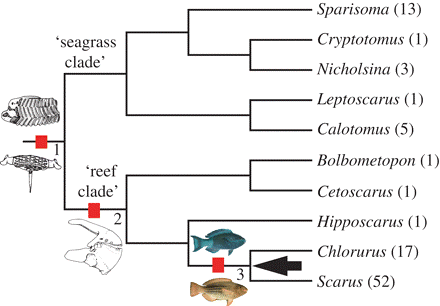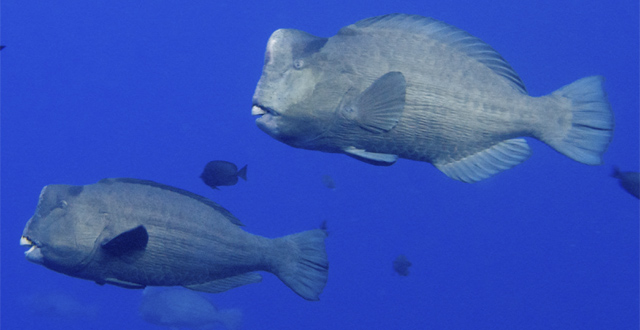Classification
Domain: Eukarya
The cells contain membrane bound organelles and a nucleus
surrounded by a nuclear membrane.
Kingdom: Animalia
The animal is multicellular, with no cell walls encasing the cells.
Our organism is also heterotrophic.
Phylum: Chordata
They are in the Chordata group because they have a notochord and
dorsal nerve chord.
Class: Actinopterygii
The Green Humphead Parrotfish is considered a ray-finned spiny fish
( characteristic of all wrasse family).
Order: Percifores
As viewed below on the phylogenetic trees the Bolbometopon
muricatum is a perch-like fish.
Family: Scaridae
All parrotfish share this family name becuse of their unique mouth
that is beak-like.
Genus: Bolbometopon
Definition is explained below.
Species: Bolbometopon muricatum
Bolbometopon is placed within the species name.
Muricatum is a Latin word that means "covered with short, sharp
points". These would be on the tail and dorsal side of the fish.
The Bolbomentopon muricatum was first found and classified
by Achille Valenciennes and Alexander von Hombolat in the years
surrounding 1840. Archille was a french zoologist who carried out
diverse classifications on organisms and linked many of them
together to help finish family trees. With Alexander von Hombolat
they traveled around the world giving authority to many species of
fish (Arkive 2008). They also helped givethe name to the
Bartail Jawfish, along with the Green Humphead Parrotfish
(Encyclopedia of Life 2009).
The Bolbometopon root name itself was classified or
given a name in 1956. The meaning of this name is an organism
that dwells in the ocean and has a verticle profile that is fully
covered with scales form head to tail (Arkive 2008). This
particular fish was said to have a distince forehead which you can
view more information on the Interactions
page.

Figure 1. Above is the phylogenetic tree of the family Labridae based
on nuclear and mitochondrial DNA sequences. This image shows the
relationship between the
Local phylogenetic divergence and global evolutionary convergence of
skull function in reef fishes of the family Labridae (Click to
see other phylogeny).
The families scaridae (Scarus) and Labridae are very closely related, that is why in the figure above Chlorurus sordidus is seen as a part of the Labridae family. All of the species that branch off scarines are different species of parrotfish. They all have the unique feature of fused teeth forming a beak, which is one of the reasons that they are grouped together. A parrotfish simular to ours is the Bullethead Parrotfish. Off of the Labridae, all of the sub-classifications are of wrasse fish. A wrasse fish is known to have a symbiotic relationship with a cleaner fish (Pacific Cleaner Shrimp) and is usually brightly colored; this describes the Chlorurus sordidus perfectly. The Napoleon Wrasse is a fish that shares part of the phylogenetic tree with the Humphead fish, which is in the Wrasse group. Our fish the Bolbometopon muricatum fits in this group as it is within the same domain, kingdom, phylum, class, order and family (Russo. 2008).

Figure 2. A phylogeny of Scaridae. The branches of this
image
represent important transitions in the evolutionary history of
parrotfishes, rather than hypothesized ancestral states. These are
modified pharyngeal jaw parts, oral jaw and teeth structure, and
sexual dichromatism. Modified jaw parts are first show after the Leptoscarus vaigiensis.
These jaw parts are
shared by all parrotfishes. Modifications in the oral jaw and
teeth structure followed and is shown in the clade onward from Scarus psittacus
(shared by the reef scarids). For more information on the jaw
funtions visit our Interactions page.
The last of these transitions is pronounced sexual dichromatism (male and female Scarus
frenatus) characterizing a subclade of reef scarids. This sexual
dichromatism isexplained in more depth on our
Reproduction page. Species totals
are in the right column, and you can view more phelogeny in the link
above (Royal Society. 2013).
To navigate to our home page simply press Home
located on every page, or continue to the
Habitat page.
